Plastic extruders are the workhorses of the plastics industry, transforming raw materials into a diverse array of products. They play a central role in extrusion production lines, working alongside various auxiliary machines to achieve continuous and efficient manufacturing. With a history spanning over a century, plastic extruders have evolved from the single-screw design to encompass twin-screw, multi-screw, and even screwless models. But how do these machines operate to shape the world around us?
The Extrusion Process: A Journey of Transformation
The plastic extrusion process can be broadly divided into three stages:
- Plasticization: The raw material, typically in the form of pellets or granules, enters the extruder and embarks on a journey of transformation. Through a combination of heating, pressurization, and shearing, the solid plastic particles are converted into a molten state.
- Shaping: The molten plastic is then conveyed by the extruder’s screw towards the die, the heart of the shaping process. The die, with its carefully designed orifice, determines the profile of the extruded product, whether it be a pipe, tube, sheet, film, or intricate profile. During this stage, colorants, additives, and other modifiers may be incorporated into the molten stream, further enhancing the product’s properties or appearance.
- Cooling and Solidification: Exiting the die, the shaped plastic encounters a cooling medium, typically water or air. This rapid cooling quenches the molten plastic, solidifying it into the desired final form. The cooled product is then pulled away from the die, completing the extrusion cycle.
The Role of the Extruder Screw: The Driving Force
At the heart of the extruder lies the screw, a rotating component that plays a pivotal role in the plasticization and shaping stages. As the screw rotates, it conveys the plastic material along its length, subjecting it to intense heating, pressurization, and shearing forces. These mechanical actions break down the polymer chains, allowing them to intermix and form a homogeneous molten mass. The screw’s design, with its specific geometry and pitch, influences the mixing efficiency, melt quality, and overall performance of the extruder.
Advantages of Extrusion: Efficiency and Versatility
The extrusion process offers several advantages over other plastic forming methods:
- High Efficiency: Extrusion is a continuous process, allowing for high production rates and minimal material waste.
- Low Unit Cost: The simplicity and efficiency of the process contribute to lower manufacturing costs per unit of product.
- Versatility: Extrusion can handle a wide range of thermoplastic polymers and produce a diverse array of product shapes and sizes.
Applications of Extrusion: Shaping a Plastic World
Extrusion finds applications in a vast array of industries, shaping the products we use daily:
- Pipes and Tubes: From plumbing pipes to electrical conduits, extrusion is the go-to method for producing these essential components.
- Films and Sheets: Packaging films, agricultural films, and geotextiles are just a few examples of products made using extrusion.
- Profiles: Window frames, door seals, and automotive trim are among the many profiles created through extrusion.
- Wires and Cables: The protective insulation and jacketing of electrical wires and cables are often produced using extrusion.
- Other Applications: Extrusion is also employed in processes like plastic compounding, pelletizing, and coloring.
Conclusion: A Cornerstone of the Plastics Industry
Plastic extruders stand as cornerstones of the plastics industry, enabling the production of a vast array of products that shape our modern world. Understanding the working principle of these machines provides a glimpse into the transformative power of extrusion, a process that continues to evolve and innovate in response to ever-changing demands.
Post time: Jun-04-2024



